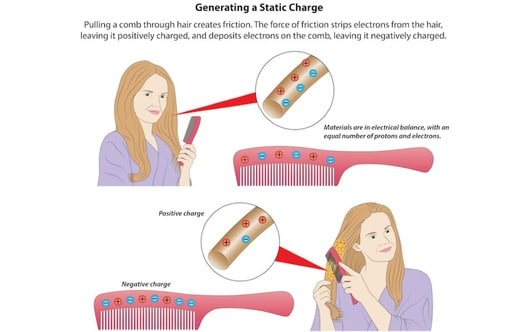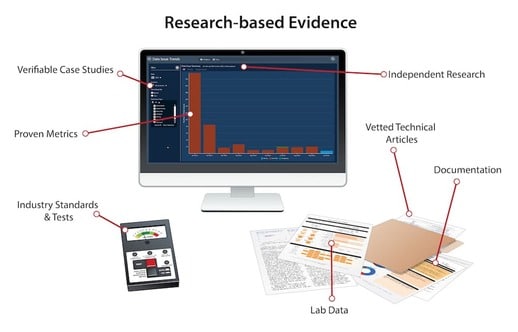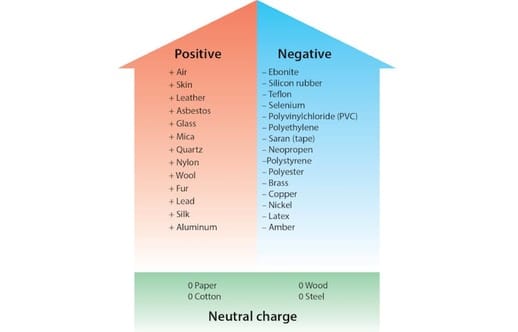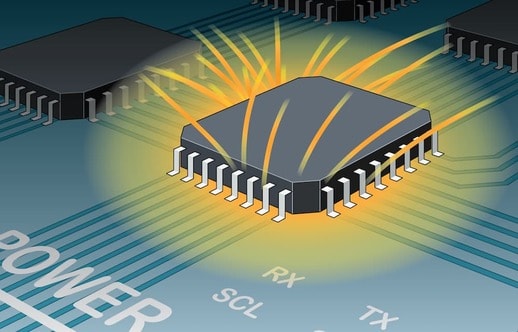
ESD Flooring timeline:
a historical perspective
Static Electricity: An Age-Old Phenomenon

The effects of electrification—or static electricity—were first observed in ancient Greece. Long before the emergence of ESD floors, static caused myriad problems in industrial manufacturing. Static charges caused unwanted adhesion or repulsion, jamming conveyor belts, clogging pipes, tangling fibers, and contaminating products and packaging. Static caused paper to stick, attracted dust, and ignited flammable liquids. Ionizing bars and air blowers neutralized charges, and wrist straps, attached to a metal surface, grounded people working on assembly lines.
Fast-Forward to the Twentieth Century
In the mid-1970s, with the economy in recession, textile mills closing and large industrial operations like auto manufacturing moving offshore, the static-control industry stagnated.

Faster Electronics Require Robust Static Protection

By the 90s, microelectronic devices were getting smaller and more sensitive to electrostatic discharge. Automated manufacturing processes required greater mobility, and ESD flooring—which grounds mobile personnel, as well as chairs and rolling carts, discharges static safely to ground, and prevents static generation—became the cornerstone of static control programs.
Our visual timeline shows how the ESD flooring industry evolved.
-
1960s and '70s
In the 1970s, ESD is slowly creeping into what will become our everyday world of PCs, PDAs, and GPSs. Flooring manufacturers are largely unaware of the need for ESD mitigation.
Most electronics companies are concerned about static/ESD and have proprietary standards and test methods, which they do not share with other companies. The common discharge value is 5000 volts, with electrical resistance set at 500 ohms.
Source for testing and standards information: In Compliance Magazine
-
1979
In 1979, military subcontractors adopt DOD-1686, the Mil spec for ESD. Flooring manufacturers race to develop groundable materials for places where ESD-sensitive equipment is handled, stored or used. Like any nascent industry, it takes a while to perfect the materials; some of the early suppliers get it right and some don’t.
-
1982
In 1982, EOS/ESD Association, an independent voluntary trade association is founded. The association is dedicated to advancing the theory and practice of avoiding electrostatic discharge (ESD). The association is initially comprised of 100 members.
Source: ESD Association
-
1984
The International Electrotechnical Commission (IEC) releases Publication 801-2, titled Electromagnetic Compatibility for Industrial-Process Measurement and Control Equipment – Part 2: Electrostatic Discharge Requirements.
While the precise technical term is static electricity discharge, the term electrostatic discharge is used in the technical world and in technical literature, so the committee decides to retain the use of ESD in the title.
Source: In Compliance Magazine
-
80s: Early Flooring Materials
Vinyl
Because static-control properties are easy to incorporate into the regular compound, vinyl becomes the material of choice for ESD flooring. By introducing veins of conductive material into standard vinyl tile, suppliers can produce a static-control floor that performs reliably, while also easily and effectively manufactured.
While ESD vinyl was a start, and a good one, it isn’t the panacea people had hoped for. Some vinyls are too soft, others too brittle to handle the heavy loads in areas where large computer equipment is assembled and moved. In wave soldering areas, spills from the solder machines melt the material. Some ESD vinyl products contain plasticizers that cannot be used in certain clean-room applications. Others use fire retardants, like halogens, which, in the event of a small fire, can create corrosive gases, damaging to unmanned spaces like the underground offices of a telephone company.
-
Epoxy
Early versions of ESD epoxy are durable and easy to maintain, but often fail conductivity tests. During the mixing process, an incomplete dispersion of conductive fibers produces an ESD floor that is not adequately conductive. To boost conductivity, it’s common practice to “shock” epoxy floors with high-voltage power supplies, a process akin to medical defibrillation.
Shocking helps bridge the insulative gaps between the suspended conductive fibers, but it doesn’t always work, particularly in cases where either an error in the mixing process or poor quality control by the chemical manufacturer produce a compound containing a deficient number of fibers or conductive particles.
-
Carpet Tile
ESD carpet has its own set of problems. The conductive fibers in the early carpets are not robust enough to withstand traffic. The fibers would break down, rendering the static-control qualities of the floor ineffective.
Conductive carpet produced in the 70s and early 80s is almost exclusively a broadloom product similar to the carpet installed in your house. Because repairs to broadloom carpet are both difficult and conspicuous, and because electronic manufacturing processes are much dirtier than they later become, most facilities managers consider carpet unsuitable for manufacturing environments.
-
Rubber
Though one of the most stable, durable, and resilient flooring materials, early ESD rubber flooring is not attractive. Early rubbers are available only in the carbon-loaded, black version of the material. Most people find this black rubber ugly or dirty-looking, and consider rubber unsuitable for large areas or for cleanrooms.
-
1995
First long-term evaluation of ESD flooring
EOS/ESD Symposium Proceedings
At the EOS/ESD Symposium, in Phoenix, Arizona, Donna Robinson-Hahn–an engineer at AT & T Microelectronics* and Program Director for all Lucent Technologies ESD Programs worldwide–presents a paper called “ESD Flooring: An Engineering Evaluation.” Her paper discusses the results of an extensive 2-year engineering study on the performance of over 20 ESD floors. Intended “to provide a thorough characterization of the electrical and mechanical properties of ESD flooring,” hers was the first long-term, objective evaluation of ESD flooring materials.
Based on her findings, Robinson-Hahn concluded that all ESD flooring systems should be tested for body voltage generation using street shoes or used only with approved ESD footwear.
* The Microelectronics group was a division of Lucent Technologies.
-
90s
According to the Sematech road map (the industry website for the semiconductor industry), ESD will present a major reliability issue for semiconductor manufacturers over the next several years.
Ted Dangelmayer, a widely recognized and respected ESD consultant, agrees. In the next five years, Dangelmayer predicts, component sensitivity, at one time over 1000 volts, will drop to as little as 25 volts, due in part to new engineering designs. The internal protection devices had made the components more robust, but encumbered circuit speed, inhibiting the production of faster, more capable components. According to Dangelmayer, the tradeoff for higher performance devices will be designs that are likely to be more vulnerable to ESD.
For further information, see The Electrostatic Technology Roadmap
-
Late 90s
In the ’80s and ’90s, as integrated circuits (IC) became smaller and more robust, manufacturers began to design on-chip ESD protection, and damage to electronic devices declined. By the late ’90s, as Dangelmayer had predicted, shrinking IC geometry outpaces the technology for on-chip ESD protection. As a result, these smaller, ultra-sensitive ICs become more vulnerable to static discharge.
Source: On Semiconductor Website
-
2000 and after
The microchips inside electronic equipment, including hand-held devices, are extremely vulnerable to static discharges. A minute, 100-volt charge—30 times smaller than any charge a human being can feel—can damage or destroy these sensitive components, disrupt data, causing lost or dropped calls, and create havoc with traffic direction.
These vulnerabilities create a need for more ESD-tolerant environments, anyplace where electronics are manufactured, handled or used. The need is especially acute in places, such 9-1-1 call centers and FAA flight towers, where sophisticated electronics are used to protect life, perform secure transactions, protect our airspace or provide mission-critical services.
-
2015
ESD is now recognized as a major source of equipment failure in manufacturing plants as well as in the field. The ESD Association estimates that 25% of all electronics damaged for unknown reasons can be attributed to ESD, with the cost of ESD damage to the electronics industry estimated at $5 billion (USD) per year.
Source: UIC.com
-
2018
The ESD Association now has 2000 members from 30 countries around the world. The Association has relationships with the Reliability Center in Japan (RCJ), Productivity Standards Board (PSB) in Singapore, Electronics Industry Association of Japan (EIAJ), ESD Forum of Germany, ESREF in Europe, China National Institute of Standardization in China (CNIS), and International Electrotechnical Commission (IEC). Members serve on Association Standards Committees, present technical papers at the annual EOS/ESD Symposium, and provide the communication links with similar organizations in other countries.
Source: EOS/ESD Association
- 1960s and '70s
- 1979
- 1982
- 1984
- 80s: Early Flooring Materials
- 1995
- 90s
- Late 90s
- 2000 and after
- 2015
- 2018
-
In the 1970s, ESD is slowly creeping into what will become our everyday world of PCs, PDAs, and GPSs. Flooring manufacturers are largely unaware of the need for ESD mitigation.
Most electronics companies are concerned about static/ESD and have proprietary standards and test methods, which they do not share with other companies. The common discharge value is 5000 volts, with electrical resistance set at 500 ohms.
Source for testing and standards information: In Compliance Magazine
-
In 1979, military subcontractors adopt DOD-1686, the Mil spec for ESD. Flooring manufacturers race to develop groundable materials for places where ESD-sensitive equipment is handled, stored or used. Like any nascent industry, it takes a while to perfect the materials; some of the early suppliers get it right and some don’t.
-
In 1982, EOS/ESD Association, an independent voluntary trade association is founded. The association is dedicated to advancing the theory and practice of avoiding electrostatic discharge (ESD). The association is initially comprised of 100 members.
Source: ESD Association
-
The International Electrotechnical Commission (IEC) releases Publication 801-2, titled Electromagnetic Compatibility for Industrial-Process Measurement and Control Equipment – Part 2: Electrostatic Discharge Requirements.
While the precise technical term is static electricity discharge, the term electrostatic discharge is used in the technical world and in technical literature, so the committee decides to retain the use of ESD in the title.
Source: In Compliance Magazine
-
Vinyl
Because static-control properties are easy to incorporate into the regular compound, vinyl becomes the material of choice for ESD flooring. By introducing veins of conductive material into standard vinyl tile, suppliers can produce a static-control floor that performs reliably, while also easily and effectively manufactured.
While ESD vinyl was a start, and a good one, it isn’t the panacea people had hoped for. Some vinyls are too soft, others too brittle to handle the heavy loads in areas where large computer equipment is assembled and moved. In wave soldering areas, spills from the solder machines melt the material. Some ESD vinyl products contain plasticizers that cannot be used in certain clean-room applications. Others use fire retardants, like halogens, which, in the event of a small fire, can create corrosive gases, damaging to unmanned spaces like the underground offices of a telephone company.
-
Epoxy
Early versions of ESD epoxy are durable and easy to maintain, but often fail conductivity tests. During the mixing process, an incomplete dispersion of conductive fibers produces an ESD floor that is not adequately conductive. To boost conductivity, it’s common practice to “shock” epoxy floors with high-voltage power supplies, a process akin to medical defibrillation.
Shocking helps bridge the insulative gaps between the suspended conductive fibers, but it doesn’t always work, particularly in cases where either an error in the mixing process or poor quality control by the chemical manufacturer produce a compound containing a deficient number of fibers or conductive particles.
-
Carpet Tile
ESD carpet has its own set of problems. The conductive fibers in the early carpets are not robust enough to withstand traffic. The fibers would break down, rendering the static-control qualities of the floor ineffective.
Conductive carpet produced in the 70s and early 80s is almost exclusively a broadloom product similar to the carpet installed in your house. Because repairs to broadloom carpet are both difficult and conspicuous, and because electronic manufacturing processes are much dirtier than they later become, most facilities managers consider carpet unsuitable for manufacturing environments.
-
Rubber
Though one of the most stable, durable, and resilient flooring materials, early ESD rubber flooring is not attractive. Early rubbers are available only in the carbon-loaded, black version of the material. Most people find this black rubber ugly or dirty-looking, and consider rubber unsuitable for large areas or for cleanrooms.
-
First long-term evaluation of ESD flooring
EOS/ESD Symposium Proceedings
At the EOS/ESD Symposium, in Phoenix, Arizona, Donna Robinson-Hahn–an engineer at AT & T Microelectronics* and Program Director for all Lucent Technologies ESD Programs worldwide–presents a paper called “ESD Flooring: An Engineering Evaluation.” Her paper discusses the results of an extensive 2-year engineering study on the performance of over 20 ESD floors. Intended “to provide a thorough characterization of the electrical and mechanical properties of ESD flooring,” hers was the first long-term, objective evaluation of ESD flooring materials.
Based on her findings, Robinson-Hahn concluded that all ESD flooring systems should be tested for body voltage generation using street shoes or used only with approved ESD footwear.
* The Microelectronics group was a division of Lucent Technologies.
-
According to the Sematech road map (the industry website for the semiconductor industry), ESD will present a major reliability issue for semiconductor manufacturers over the next several years.
Ted Dangelmayer, a widely recognized and respected ESD consultant, agrees. In the next five years, Dangelmayer predicts, component sensitivity, at one time over 1000 volts, will drop to as little as 25 volts, due in part to new engineering designs. The internal protection devices had made the components more robust, but encumbered circuit speed, inhibiting the production of faster, more capable components. According to Dangelmayer, the tradeoff for higher performance devices will be designs that are likely to be more vulnerable to ESD.
For further information, see The Electrostatic Technology Roadmap
-
In the ’80s and ’90s, as integrated circuits (IC) became smaller and more robust, manufacturers began to design on-chip ESD protection, and damage to electronic devices declined. By the late ’90s, as Dangelmayer had predicted, shrinking IC geometry outpaces the technology for on-chip ESD protection. As a result, these smaller, ultra-sensitive ICs become more vulnerable to static discharge.
Source: On Semiconductor Website
-
The microchips inside electronic equipment, including hand-held devices, are extremely vulnerable to static discharges. A minute, 100-volt charge—30 times smaller than any charge a human being can feel—can damage or destroy these sensitive components, disrupt data, causing lost or dropped calls, and create havoc with traffic direction.
These vulnerabilities create a need for more ESD-tolerant environments, anyplace where electronics are manufactured, handled or used. The need is especially acute in places, such 9-1-1 call centers and FAA flight towers, where sophisticated electronics are used to protect life, perform secure transactions, protect our airspace or provide mission-critical services.
-
ESD is now recognized as a major source of equipment failure in manufacturing plants as well as in the field. The ESD Association estimates that 25% of all electronics damaged for unknown reasons can be attributed to ESD, with the cost of ESD damage to the electronics industry estimated at $5 billion (USD) per year.
Source: UIC.com
-
The ESD Association now has 2000 members from 30 countries around the world. The Association has relationships with the Reliability Center in Japan (RCJ), Productivity Standards Board (PSB) in Singapore, Electronics Industry Association of Japan (EIAJ), ESD Forum of Germany, ESREF in Europe, China National Institute of Standardization in China (CNIS), and International Electrotechnical Commission (IEC). Members serve on Association Standards Committees, present technical papers at the annual EOS/ESD Symposium, and provide the communication links with similar organizations in other countries.
Source: EOS/ESD Association
Get in Touch
The form below will help us better understand your needs and get you as quickly as possible to the right person. We look forward to helping you solve your static problem!
You can expect a response within 24 hours. For faster service, please give us a call: 617-923-2000
"*" indicates required fields
Visit our privacy policy to find out how we process data.
Learning Center Articles
- ESD Basics
- Installation & Maintenance
- Selecting & Specifying an ESD Floor
- Technical Information
- 7 Common Mistakes Selecting an ESD floor
- A Guide to ESD Flooring Selection
- Avoid Costly Failures: What You Need to Know When Specifying ESD Flooring
- Choosing ESD Flooring for:
- ESD Footwear: What Is It and When Is It Necessary?
- ESD Footwear for Electronics Manufacturing and Handling Applications
- Facility Managers’ Guide to Selecting ESD Flooring
- The Need for Due Diligence in Specifying Static-Free Flooring
- Standard of Care for Specifying Floors in Mission-Critical Spaces
- Understanding the Hidden Costs of ESD Flooring

StaticWorx high-performance static-control floors protect electronic components, explosives, and high-speed computers from damage caused by static electricity. ESD flooring is part of a system. Choices should always be based on objective, researched evidence. When you partner with us, we look at all possible items that may need to integrate with the floor, and, focusing on your goals and objectives, help you find the right floor for your application.
























